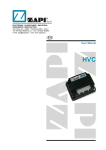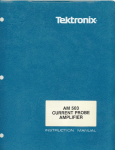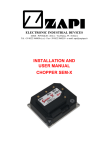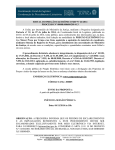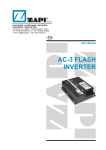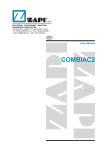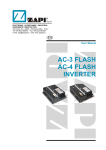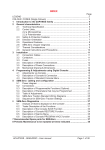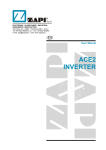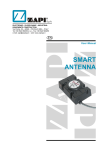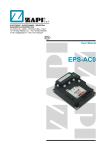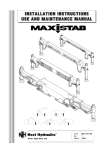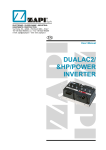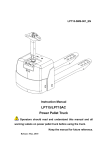Download 4Q CONTROLLER OPERATING AND USER MANUAL
Transcript
ELECTRONIC INDUSTRIAL DEVICES 42028 - POVIGLIO - (R.E.) - Via Parma, 59 - ITALIA Tel. +39 0522 960050 (r.a.) - Fax +39 0522 960259 - e-mail: [email protected] 4Q CONTROLLER OPERATING AND USER MANUAL Index 1 Main features ................................................................................................. 1.1 Field of application .................................................................................... 1.2 Control units .............................................................................................. 1.2.a Microswitches ............................................................................... 1.2.b Potentiometer ............................................................................... 1.3 Safety features .......................................................................................... 1.4 Operating functions ................................................................................... 1.5 Controller diagnosis ................................................................................... 1.6 Thermal considerations ............................................................................. 1.7 General warnings and precautions 2 3 4 5 6 3 3 4 4 4 5 6 6 7 .................................................... 7 Installation...................................................................................................... 8 2.1 Choice of connecting cables...................................................................... 8 2.2 Fuses ......................................................................................................... 8 2.3 Description of connectors .......................................................................... 9 2.4 Dimensions .............................................................................................. 10 2.5 Connections ............................................................................................ 11 2.5.a Pallet truck.................................................................................. 11 2.5.b Floor washer............................................................................... 12 Console Menu .............................................................................................. 13 3.1 Programming with the console ................................................................ 13 3.2 Console Map ........................................................................................... 14 3.2.a Pallet truck.................................................................................. 14 3.2.b Floor washer............................................................................... 15 3.3 "Tester" Menu .......................................................................................... 16 3.3.a Pallet truck.................................................................................. 16 3.3.b Floor washer............................................................................... 16 3.4 "Parameter Change" Menu ...................................................................... 17 3.4.a Pallet truck.................................................................................. 17 3.4.b Floor washer............................................................................... 17 3.5 "Set Model" Menu .................................................................................... 18 3.6 "Set Option" menu ................................................................................... 18 3.6.a Pallet truck.................................................................................. 18 3.6.b Floor washer............................................................................... 20 3.7 "Adjustment" Menu .................................................................................. 21 3.8 "Hardware Setting" Menu ........................................................................ 22 3.9 "Special Adjust" Menu ............................................................................. 23 3.10 "Clear EEprom" Menu ........................................................................... 23 Alarms .......................................................................................................... 24 4.1 Diagnosis ................................................................................................. 24 Recommended spare parts for the 4Q ...................................................... 27 Regular maintenance at set intervals ........................................................ 28 Page 1 = The informations included into the marked paragraphs by this symbol are essential for the safety. SIGNATURES TABLE COMPANY DEPT. SERVICES ENGINEERING SECTION EXECUTIVE EXPORT MANAGER Publication N°: ADMZP0DA Edition: November 2001 Page 2 MANAGEMENT EXECUTIVE 1 MAIN FEATURES The 4Q is the smallest permanent magnet motor controller: it is designed for use at 24Vor 36V with a maximum armed current of 70A or 90A. The controller is constructed with a full bridge: no changeover necessary. 1.1 FIELD OF APPLICATION Power 500W (800W) Voltages 24V, 36V Max. current 70A (90A) Continuos current 30A The following inputs are foreseen: - tiller / seat microswitch - quick inversion - forwards - reverse - potentiometer with 3 wires - speed reduction 1 - speed reduction 2 The controller has 2 outputs: - EV1 (solenoid valve) - EV2 (electric brake) The main contactor (relay) is internal. The 4Q controller can be configured in two different ways: - Pallet truck (Model 1) - Floor washer (Model 2) The parameters, tester and options may vary according to the model chosen with ZAPI console. Page 3 1.2 CONTROL UNITS 1.2.a Microswitches - A contact resistance of less than 0.1Ω and a current leakage of less than 100µA is required. - The key contact must be able to take all the current of the loads without causing a voltage drop of more than 01.V between contacts. - Send a voltage signal to the microchip when a function is requested (e.g. start running). 1.2.b Potentiometer Potentiometer configured with 3 wires. The CPOT range varies from 0 to 10V. Minimum resistance: 500 Ω Maximum resistance: 10KΩ Automatic minimum and maximum signal acquisition must be carried out (PROGRAM VACC function) using the programming console and in both directions. This function is indispensable when compensating an eventual asymmetry in the mechanical components of the potentiometer and for minimum level adjustment in particular. The above graphs show the output voltage of a potentiometer that has not been calibrated compared to the mechanical “zero” of the tiller knob (MI and MA indicate the closing points of the microswitches, 0 represents the mechanical angle of rotation of the throttle). The first graph shows the corresponding motor voltage without acquisition; the second graph shows the corresponding voltage after potentiometer signal acquisition. Page 4 1.3 SAFETY FEATURES - Inverted battery polarity: Connections must be made as indicated in the wiring diagrams to avoid damaging the power unit. - Connection errors: All the inputs are protected against wrong connection. - Thermal protection: If the temperature of the 4Q exceeds 75°C, the maximum current is automatically reduced in proportion to the temperature increase. The temperature cannot exceed 90°C, at this temperature the maximum current is zeroed. If the temperature drops to below –10°C, the maximum current is reduced by 20%. - Battery low: When the battery runs down (<= 10%) the maximum current is reduced by 50%. This function can be excluded using the console (“Battery Check” option). - External agents: The chopper has IP54 protection. - Protection against accidental starting: A precise sequence of operations is required to start the machine, if the sequence is not carried out correctly the machine will not start. The start running command must be given after key-on and activating the seat microswitch, if configured. If on the other hand the tiller is configured, it must be activated with a predefined minimum delay time compared to the activation of a start running microswitch. - Protection against uncontrolled movement: The electromagnetic switch does not close if: - the power unit is not in function, - the output voltage of the accelerator does not drop to below the recorded minimum value increased by 1V, - the potentiometer negative is disconnected, - the logic is not in good working order, - one of the start microswitches is closed. - the controller fulfil the requirements specified on the EN1175 (point 5.9.4). The requirements specified on point 5.9.5 have to be fulfil by external solutions. Page 5 1.4 OPERATING FUNCTIONS - Speed control. - Excellent sensitivity at low speeds. - Maximum speed reduction: the maximum speed in both directions can be adjusted using the programming console. - Regenerative braking based on deceleration ramps, release braking, inversion braking. - Speed control in descent: the motor speed is controlled by the accelerator pedal and regenerative braking is activated automatically if the motor speed exceeds the required speed; this results in excellent ramp performance. - Even without the use of an electric brake anti roll-back. - Electric brake control (optional). - Diagnosis with optional led to indicate type of fault. - Parameter adjustment using console. - Internal hour-counter, displayed on the console. - The last 5 alarms are recorded together with the relative hour-counter reading and chopper temperature. - Tester function using the console to check in real time: inputs, motor voltage, battery, etc. - Good motor and battery efficiency thanks to high frequency switching. - Watchdog circuit to check the µC operations. - An MDI indicator can be connected to display: software version, hour counter, alarms, speed reduction and battery charge. 1.5 CONTROLLER DIAGNOSIS The µC diagnoses the main chopper functions. Diagnosis consists of 4 main stages and includes the following tests: 1) Key turned on: test current sensor, test VMN, test main relay, test presence of start command, test accelerator high, test potentiometer connection, test watchdog, test power devices. 2) At rest: test VMN, test main relay, test current sensor, test potentiometer connection, test watchdog, test accelerator up in absence of start microswitch. 3) Running: test VMN, test main relay, test current sensor, test negative wire of potentiometer, test watchdog, test electric brake (if configured). 4) Permanent: check temperature and battery voltage. Diagnostic messages are coded by counting the number of times the led flashes or by a 2 digit code on the MDI. The full alarm message can be visualised using the programming console. Page 6 1.6 THERMAL CONSIDERATIONS - Since the heat generated by the controller must be dissipated, it is important to install it in a well ventilated area with adequate cooling surfaces. - The cooling system must be scaled according to the use required of the machine; forced ventilation may be necessary in some cases if air circulation is insufficient and heat exchange is limited by the type of materials used. - The power dissipated by the module varies according to the current and the duty cycle. 1.7 GENERAL WARNINGS AND PRECAUTIONS - Do not connect the 4Q module to a battery with a different rated voltage to the one indicated on the module’s rating plate. A higher battery voltage can cause irreparable damage the MOSFETs. With a lower battery voltage the module will not work. - The 4Q module must be disconnected when the battery is being charged as the module can be damaged by overvoltages generated by the battery charger and ripple currents generated in the capacitors if a low frequency battery charger is used. - The 4Q module should be powered by batteries for traction only. Do not use rectifier outputs or power supply units. For special applications contact the nearest ZAPI technical service centre. - When starting the machine for the first time keep the wheels raised to avoid hazardous situations due to possible connection errors. - When the key is turn off the filter capacitors in the module can stay charged for several minutes. For safety purposes it is advisable to disconnect the battery and short circuit the positive and negative power lines of the chopper for a few seconds using a resistor of between 10Ω and 100Ω . - The electromagnetic susceptibility and emission is strongly influenced by the method of installation; particular attention should be paid to the length and lay-out of electrical connections and to shielding. Zapi declines all responsibility for malfunctions caused by the above mentioned factors, particularly if the machine manufacturer fails to carry out the tests required by current legislation. Page 7 2 INSTALLATION If possible, assemble the chopper with its base on a flat metal surface that has not been painted or cleaned. It is advisable to spread a layer of thermo-conductive grease between the two surfaces to improve the transmission of heat. Although the chopper is protected against external agents, the connector contacts may become oxidised due to the presence of corrosive substances. This factor should be taken into consideration when choosing where to install the chopper on the vehicle. Secure the chopper using the pre-drilled holes on the aluminium fixing plate. Check to make sure that the cable terminals and connectors are wired correctly. Remember to install a snubber circuit on the horn, relays, solenoid valves and electromagnetic switches not connected to the chopper, such as the motor pump contactor. 2.1 CHOICE OF CONNECTING CABLES Use cables with a cross section of 0.5mm2 for auxiliary circuits. Use 6mm2 cables for power connections to the motor and to the battery. The cables connecting the chopper to the battery should be laid side-by-side and be as short as possible. 2.2 FUSES - Use a 6A fuse to protect auxiliary circuits. - Use a 50A fuse to protect the power unit. The values given are the maximum permitted values and can be reduced for special applications or requirements. For safety purposes is it advisable to use shielded fuses to prevent molten particles being scattered in the event of a blowout. Page 8 2.3 DESCRIPTION OF CONNECTORS pin function description A1 CPOTT Potentiometer unit: connect to the cursor of the accelerator potentiometer. A2 NPOTT Negative pole of accelerator potentiometer. A3 PPOTT Positive pole of accelerator potentiometer. A4 TILLER Tiller/seat switch signal input (or hydro request input if the chop per is configured as a floor washer). A5 BELLY Quick inversion switch input. A6 FORWARD Forward switch input. A7 BACKWARD Reverse switch input. A8 RV1 Cutback switch 1 input A9 RV2 Cutback switch 2 input A10 NEV1 Negative pole of solenoid valve 1 A11 NEB/NEV2 Negative pole of electric brake or solenoid valve 2. A12 PEV2 Positive pole of solenoid valve 2. A13 PEV1 Positive pole of solenoid valve 1. A14 PEB Positive pole of electric brake. A15 CM Common switch (voltage output using battery potential). A16 KEY Key input. B1 PCLRXD Serial reception positive. B2 NCLRXD Serial reception negative B3 PCLTXD Serial transmission positive. B4 NCLTXD Serial transmission negative. B5 GND Negative for powering console. B6 +12 Positive for powering console. B7 --- B8 --- Page 9 2.4 DIMENSIONS Page 10 2.5 CONNECTIONS 2.5.a Pallet truck Page 11 2.5.b Floor washer Page 12 3 CONSOLE MENU 3.1 PROGRAMMING WITH THE CONSOLE The Zapi console can be used to program various 4Q chopper functions. It is therefore possible to adapt the truck performance to suit the client’s requirements. The console can be left connected to the controller when it is in use and the parameters can be modified in real time. In this case, if you wish to save the new data entries, get into rest mode and save the data in the controller memory (E2prom) before turning the key off. This section describes the functions of the Zapi console. The console has six push-buttons that can be used to modify or visualise the chopper parameters as described below: 1 Roll-up press to scroll sub-menus or parameters upwards. 2 Roll-down press to scroll sub-menus or parameters downwards. 3 Enter press to access sub-menus. Also used to confirm a new parameter. 4 Out press to exit sub-menus. Also used for non-confirmation of a new parameter. 5 Set-Up press to increase the value of a parameter. 6 Set-Down press to decrease the value of a parameter. N.B.: When a parameter has been modified, the new value can be recorded by pressing key 4 (Out) followed by key 3 (Enter). By pressing key 4 (Out) twice, the new value is not recorded. The numbers printed in the triangles on the following console map correspond to the numbers on the keyboard of the console shown in the diagram below. The position of the triangle indicates to which sub-menu or parameter the key refers. Important THE CONSOLE SHOULD ONLY BE CONNECTED AND DISCONNECTED WITH THE PLANT TURNED OFF! Page 13 3.2 CONSOLE MAP 3.2.a Pallet truck Page 14 3.2.b Floor washer Page 15 3.3 "TESTER" MENU 3.3.a Pallet truck BATTERY VOLTAGE battery voltage VMN VMN voltage MOTOR CURRENT motor current TEMPERATURE chopper temperature ACCELERATOR accelerator FORWARD SWITCH forward input BACKWARD SWITCH reverse input TILLER SWITCH tiller switch input CUTBACK SWITCH 1 speed reduction 1 input CUTBACK SWITCH 2 speed reduction 2 input (if configured) BELLY SWITCH quick inversion input BACKING INPUT backing input (if configured) TOGGLE INPUT toggle input (if configured) BATTERY CHARGE charge status of battery 3.3.b Floor washer BATTERY VOLTAGE battery voltage VMN VMN voltage MOTOR CURRENT motor current TEMPERATURE chopper temperature ACCELERATOR accelerator FORWARD SWITCH forward input BACKWARD SWITCH reverse input HYDRO SPEED REQ. request exclusive hydro (if configured) CUTBACK SWITCH 1 speed reduction 1 input CUTBACK SWITCH 2 speed reduction 2 input (if configured) BELLY SWITCH quick inversion input BATTERY CHARGE charge status of battery Page 16 3.4 "PARAMETER CHANGE" MENU 3.4.a Pallet truck ACCELER. DELAY Acceleration time; 9 = maximum time DECELER. DELAY Deceleration time; 9 = maximum time RELEASE BRAKING Release braking time; 9 = max. braking power, minimum time INVERS. BRAKING Inversion braking time; 9 = max. braking power, minimum time CUTBACK SPEED 1 Speed reduction 1 CUTBACK SPEED 2 Speed reduction 2 MAX FORW. SPEED Maximum forward speed MAX BACK. SPEED Maximum reverse speed TRACTION IMAX Maximum current (it's a function of the parameter MAXIMUM CURRENT) CREEP SPEED Initial step voltage BACKING TIME Backing time BACKING SPEED Fixed speed during backing function SEAT MICRO DELAY Seat microswitch release delay time (if the “Handle Switch option” is configured as “Seat”); or delay between direction request and tiller (if the “Handle Switch option” is configured as “Present”). HYDRO TIME Delayed disengaging of hydro output. 3.4.b Floor washer ACCELER. DELAY Acceleration time; 9 = maximum time DECELER. DELAY Deceleration time; 9 = maximum time RELEASE BRAKING Release braking time; 9 = max. braking power, minimum time INVERS. BRAKING Inversion braking time; 9 = max. braking power, minimum time CUTBACK SPEED 1 Speed reduction 1 CUTBACK SPEED 2 Speed reduction 2 MAX FORW. SPEED Maximum forward speed MAX BACK. SPEED Maximum reverse speed TRACTION IMAX Maximum current (it's a function of the parameter MAXIMUM CURRENT) CREEP SPEED Initial step voltage AUXILIARY TIME Delayed disengaging of auxiliary output NEV2. HYDRO TIME Delayed disengaging of hydro output (NEV1). Page 17 3.5 "SET MODEL" MENU Model Type Option #1 The 4Q is configured as a transpallet. Option #2 The 4Q is configured as a floor washer. 3.6 "SET OPTION" MENU 3.6.a Pallet truck Hour counter Running The hour counter is active during running only. Key on The hour counter is active at all times. Battery check Off Battery alarm disengaged. On Low battery alarm engaged (plus current limiting device). Aux output #1 (NEV2 - NEB output) Free Unused output Brake Output used to control an electric brake that receives the positive from the tiller switch (with relative diagnosis). Option #2 Output used to control an electric brake that does not receive the positive from the tiller switch (diagnosis disengaged). Option #3 Output used to enable the electric brake during release braking. The brake is controlled as in the option "brake". Quick inversion Belly Quick inversion active while the belly button remains pressed. Timed Timed quick inversion (fixed duration). Backing function This option is effective only if the “Set input #2” is set to “Option #1” Off The backing function is disengaged; the RV2 input is a speed reduction. On The backing function is enabled; the RV2 input is used to activate the backing function, the direction is chosen using the gears. Page 18 Handle switch Present Tiller present: incorrect start if pressed at key-on and movement jammed if released during running. A maximum delay time between selecting the running direction and selecting the tiller can be programmed using the “Seat micro delay” parameter. Seat Seat present: no incorrect start is pressed at key-on, delay if released during running (program the delay time using the “Seat micro delay” parameter). The seat-running sequence is compulsory. Aux output #2 (NEV1 output) This option is only effective if “Set input # 2” is set to “Option #1”. Option #1 The NEV1 output acts as a hydro: it is active during running and is set at rest with a programmable delay time after running. Option #2 The NEV1 output is activated when a thermal alarm is present (e.s. can be used to activate a fan) Set input #2 Option #1 The “Aux output #2” and “Backing function” options can be used. Option #2 The “Aux output #2” and “Backing function” options have no effect. The “RV2” input is not a speed reduction but is used as a button (Toggle); the NEV1 output is activated by an “RV2” impulse and disengaged by a second impulse. Inversion Mode Option #1 The quick inversion input is configured as normally open. Option #2 The quick inversion input is configured as normally closed. Aux function #2 Option #1 The potentiometer is configured with an electric range of 0V5V. Forward and backward micros are present. Option #2 The potentiometer is configured with an electric range of 0V2.5V-5V (2.5V is the ‘at rest’ value). Forward and backward micros are not used; the direction is given by the voltage on the potentiometer unit: 2,5V 5V = backward Page 19 Set battery type Sets the battery nominal value 24V 24V battery. 36V 36V battery. 3.6.b Floor washer Hour counter Running The hour counter is active during running only. Key on The hour counter is active at all times. Battery check Off Battery alarm disengaged. On Low battery alarm enabled (plus current limiting device). Quick inversion Belly Quick inversion is active while the button remains Timed Timed quick inversion (set duration). Inversion Mode Option #1 The quick inversion input is configured as normally open. Option #2 The quick inversion input is configured as normally closed. Automatic function Off To be defined. On The NEV2 output is active during running and is disengaged with a programmable delay time. The output is always disengaged when a low battery alarm is present. Aux function #2 The tiller/seta switch is not used by cleaning machine, so the input can be used for other purpose. Option #1 The “Tiller/Seat” input is a switch that activates the NEV1 output. When the switch is opened the output is disengaged with a delay time that is programmed by the “Hydro Time” parameter. Option #2 Page 20 The “Tiller/Seat” input is a button that activates the NEV1 output when pressed once. Pressing a second time disengages the output with a delay time that is programmed by the “Hydro Time” parameter. Option #3 If the “Tiller/Seat” input is activated without traction it activates NEV1 for a duration that is programmed by the “Hydro Time” parameter. If the input is activated with traction then the NEV1 output is permanently active. If traction stops, NEV1 remains active for a certain length of time that can be programmed by the “Hydro Time” parameter. If the “Tiller/Seat” input is disengaged, NEV1 disengages immediately. The low battery alarm disengages NEV1 (used to drive brushes). Set battery type Sets the battery nominal value 24V 24V battery. 36V 36V battery. 3.7 "ADJUSTMENT" MENU Throttle 0 zone This parameter is used to set the dead zone of the traction potentiometer. See graph below. Throttle X zone This parameter is used to adjust the characteristic of the traction potentiometer signal. Throttle Y zone This parameter is used to adjust the characteristic of the traction potentiometer signal. Adjust battery Fine adjustment of the battery voltage. Page 21 3.8 "HARDWARE SETTING" MENU Set current Adjust the bottom of the scale setting of the current reading visualised on the console. Adjustment #01 Adjust the maximum value of the low battery curve. Adjustment #02 Adjust the minimum value of the low battery curve. Aux function #1 On The hour counter of the chopper loads the MDI hour counter. Off If the hour counter of the chopper and the MDI have different values, alarm “98” is displayed for one minute; if the option is not set to “On” within the minute then the chopper hour counter overwrites the MDI hour counter (0 hours if the chopper is new). Check up done On the programmed check-up has been carried out; the maintenance hour counter and the “Check up needed” alarm are reset. Off checkup not done. Page 22 Check up type None Programmed maintenance function disengaged; no alarm, no reduction, no shut down. Option #1 Programmed maintenance function enabled; an alarm message is visualised after 300 hours. Option #2 Programmed maintenance function enabled; an alarm message is visualised after 300 hours and a speed reduction is enabled after 340 hours Option #3 Programmed maintenance function enabled; an alarm message is visualised after 300 hours, speed reduction is enabled after 340 hours and the traction is blocked after 380 hours. 3.9 "SPECIAL ADJUST" MENU Set temperature Fine adjustment of chopper temperature (the chopper temperature is calibrated by Zapi during testing and should not be modified by the client). Maximum Current Adjust the maximum chopper current. A password is required in order to modify this setting and remains active until the key is turned off. 3.10 "CLEAR EEPROM" MENU Clear EEprom can be effected from this menu; this virtually resets the plant and cancels the settings entered up to that moment. At the end of the Clear EEprom operation the original settings (default values) are reloaded. Clear EEprom has no effect on the following settings: - Model Type - Maximum Current - Set temperature - Adjust Battery Page 23 4 ALARMS 4.1 DIAGNOSIS 1) POWER FAILURE #1 AL 73 MDI 1 LED FLASH Short circuit on main relay or on auxiliary outputs (NEV1, NEV2). 2) CAPACITOR CHARGE AL 60 MDI 3 LED FLASHES This alarm is signalled if the capacitors have not begun re-charging after a certain amount of time has lapsed. Possible causes: fault in the potentiometer unit. 3) DRIVER SHORTED Short circuit on driver of main relay. 4) VMN NOT OK AL 32 MDI 3 LED FLASHES Test at rest with the main relay open and running. If the VMN is very low and the main relay is open, the chopper goes into alarm. When running, an alarm is signalled if the VMN does not move from the half battery value according to the direction of the duty cycle: for forward running the VMN value should go from Vbatt/ 2 to zero, in reverse the VMN should go from Vbatt/2 to Vbatt. Possible causes: a) incorrect motor connection; b) motor leak to earth; c) fault in the power unit. 5) STBY I HIGH AL 53 MDI 5 LED FLASHES Test during initial diagnosis and at rest with main relay open. Check to ensure that current signals are nil. If not the chopper goes into alarm and prevents machine functions. Possible causes: a) faulty current sensor; b) fault in the feedback circuit, in the logic or in the power board. 6) LOW BATTERY AL 66 MDI 32 LED FLASHES Reduces the traction current to Imax/2. The low battery alarm is activated when the residual charge falls to 10%. If the alarm is activated with the battery fully charged, check the battery value reading in the “TESTER” menu on the console; if the reading is incorrect, carry out fine adjustment in the “CONFIG MENU/ ADJUSTMENT” menu. This alarm can be present only with "battery check" option ON. 7) CONTACTOR CLOSED AL 37 MDI 6 LED FLASHES Test before closing the main relay, only if the VMN is at approx. Vbatt/2. Check that the contact of the main electromagnetic switch is open and has not jammed. Page 24 AL 74 MDI 6 LED FLASHES 8) 9) CONTACTOR DRIVER AL 75 MDI 6 LED FLASHES Test with the main relay closed, check that the driver is not open. Possible causes: a) driver open; b) fault in the feedback circuit of the main relay coil voltage. I=0 EVER AL 49 MDI 5 LED FLASHES Test whilst running. Check that the current value is higher than the minimum threshold value. If not the chopper will go into alarm and prevent machine functions. Possible causes: a) faulty current sensor; b) fault in the feedback circuits, in the logic or in the power board. 10) EB DRIVER KO AL 02 MDI 8 LED FLASHES The alarm is activated when a problem in the driver of the electric brake is detected (only for transpallets with brake present and diagnosis enabled). Possible causes: a) shorted driver; b) the driver is faulty and cannot control the electric brake; c) fault in the feedback circuit of the electric brake coil voltage. 11) WATCHDOG AL 08 MDI 1 LED FLASHES Test both at rest and running: this is an internal self-diagnosis of the logic. If this alarm is signalled, replace the logic. 12) CHECK-UP NEEDED AL 99 MDI 0 LED FLASH Indicates that it is time to carry out programmed maintenance; this alarm is activated 300 hours after the last time maintenance was carried out unless the “Check up type” option is set to “None”; cancel by setting “Check-up done” to ON. 13) FORW + BACK AL 80 MDI 2 LED FLASHES Test carried out continuously. The alarm is activated when 2 running requests are given simultaneously. The alarm is reset if one of the two requests is cancelled. Possible causes: a) check wiring; b) if fault persists, replace the logic. 14) VACC NOT OK AL 78 MDI 4 LED FLASH This alarm indicates that the traction accelerator voltage is 1V higher that the minimum programmed voltage at key-on and when at rest. Possible causes: a) a potentiometer wire is disconnected; b) the potentiometer is not wired correctly; c) the potentiometer is faulty; d) potentiometer programming has not been carried out correctly. Page 25 15) INCORRECT START AL 79 MDI 2 LED FLASHES Forwards/reverse, tiller, quick inversion present at key-on; traction running request given before tiller/seat. 16) THERMAL PROTECTION AL 62 MDI 7 LED FLASHES Temperature alarm activated if the temperature is >+75°C in which case the maximum armature current is reduced linearly until it reaches nil at a threshold temperature of 90°C; the speed is reduced to 60%; the alarm is reset only if the temperature drops to below 70°C. If the temperature falls to below –10°C the maximum armature current is reduced by 20%. 17) EEPROM OK AL 13 MDI 1 LED FLASH Fault in the memory area where configuration parameters are recorded. If the fault persists when the key is turned off and turned on again, replace the EEPROM and check the connections between the EEPROM and the µP. If the alarm no longer occurs, remember that the previously recorded parameters have now been cancelled and replaced with default values. 18) PEDAL WIRE KO AL 86 MDI 4 LED FLASHES Indicates that the negative wire of the potentiometer is disconnected. Possible causes: a) one of the potentiometer wires is disconnected; b) the potentiometer is not wired correctly; c) the potentiometer is faulty. 19) CURR. PROTECTION AL 96 MDI 5 LED FLASHES Current protection; if for any reason the current exceeds the calibrated values, the microprocessor disengages the functions until the current drops to the required value. AL 98 on MDI: MDI and chopper have different counter. Page 26 5 RECOMMENDED SPARE PARTS FOR THE 4Q ITEM CODE DESCRIPTION C12404 C12777 C00077 C18556 C18557 16 way Molex Minifit female connector Molex Minifit female crimp terminal Console connector plug Outer gasket for Molex Minifit connector Inner gasket for Molex Minifit connector Page 27 6 REGULAR MAINTENANCE AT SET INTERVALS Check the pedal microswitch: use a tester to check for the absence of resistance on the contact by measuring the voltage drop at the terminals, also check that the switch clicks clearly; ............................................................................................... EVERY 3 MONTHS Check the power cables to the battery and to the motor, both cables and the sheathing must be in good condition; ................................................................ EVERY 3 MONTHS Check the efficiency of the pedal springs; ......................................... EVERY 3 MONTHS All work must be carried out by qualified staff and original spare parts only should be used. Follow the assembly diagrams carefully when installing the machine, any modifications must be agreed to with the supplier. The supplier declines all responsibility for problems caused by failure to comply to the proposed solutions. Any cause for concern that is visible or apparent to the average technician when carrying out the regular check-ups on the equipment, and that could result in damage or faults to the equipment itself, must be reported to ZAPI technicians or to the technical sales network who are responsible for any decisions concerning the safety of the electric vehicle. THE USER IS PROHIBITED FROM USING THE VEHICLE SHOULD THERE BE ANY FAULTS IN THE ELECTRICAL EQUIPMENT THAT REPRESENT A HAZARD.





























